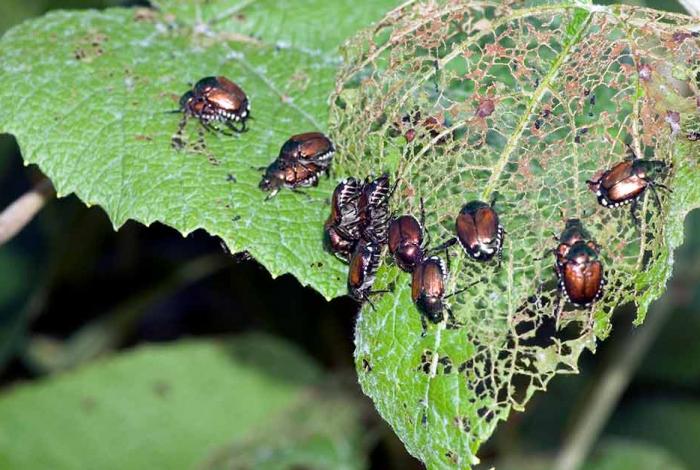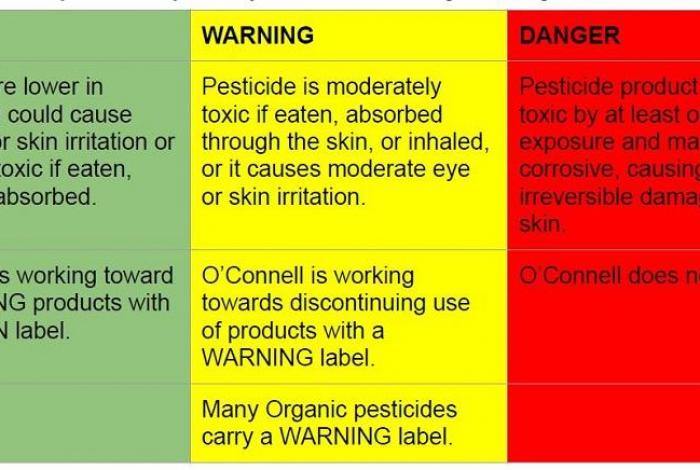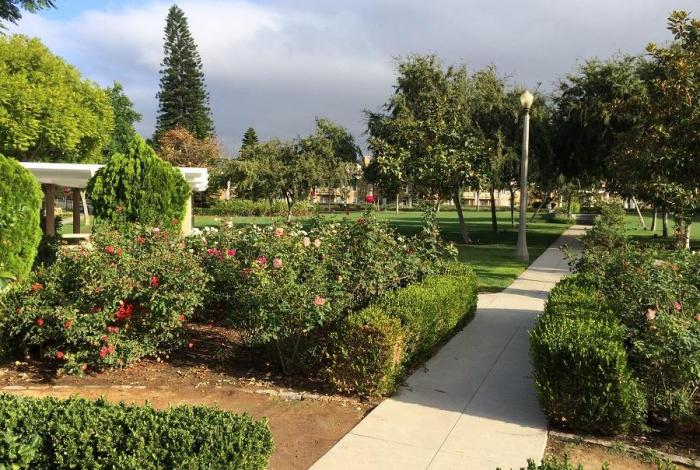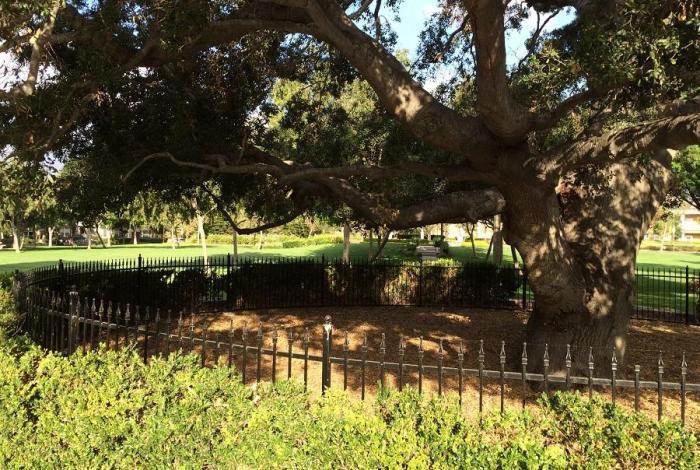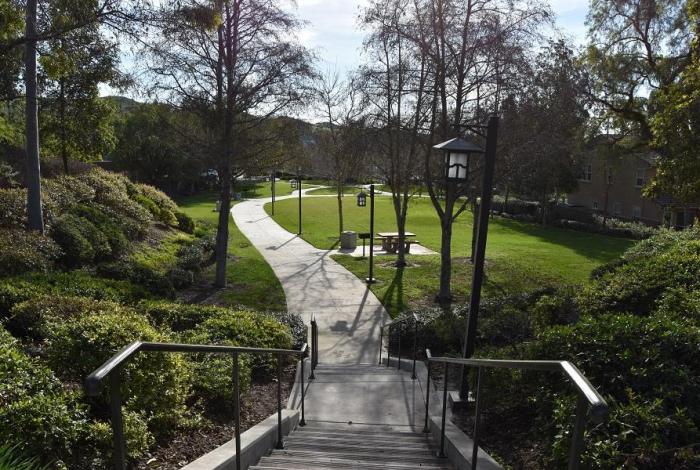Your HOA at Work
- Homepage
- About
- larmac
- Your HOA at Work
- Pest Management
- Pest Management
LARMAC shares what it is doing to maintain Ladera's landscape and open spaces at a high standard with the use of labor and organic and traditional materials. Materials are used to control pests that include weeds and other invasive pests. It's noted that organic materials aren't necessarily deemed 'safe'. LARMAC shares what it's doing to consider alternative materials and technologies while balancing the effectiveness with costs.
LARMAC is committed to maintaining Ladera Ranch at high standards which includes the aesthetic appeal of its parks, open spaces, green belts, pools, clubhouses and other amenities.
In LARMAC’s mission to maintain the community – public safety, visible results and financial responsibility are at the forefront when undertaking the care of the community which encompasses 850 acres of manufactured landscape and over 48,000 trees.
In a perfect world, every weed might be pulled by hand and synthetic or organic materials would be used. Currently incorporating a ‘no materials/all-labor’ program to maintain a community the size of Ladera is not financially feasible due to the constraints of LARMAC’s annual budget which is driven by homeowner assessments. Therefore, government-approved materials are used by licensed landscape professionals who treat LARMAC’s manufactured landscape property with care and within approved standards.
Exploring alternatives
In 2017, LARMAC began researching and exploring alternate pest management options, that differed from traditional methods, which are widely used by communities and cities in our area. This included:
- Participating in test plot studies: Both traditional and non-traditional materials were used, including numerous recommended organic materials.
- Meeting with organic pest management companies: LARMAC and its contractors have met with representatives from numerous organic pest management companies to learn more about their products.
- Consulting with horticultural experts: LARMAC consults with its contractors and numerous consultants, including pest management experts.
- Learning from other communities: Significant time and effort has been spent understanding what other communities and/or cities are doing. Understanding lessons learned along the way has been helpful for LARMAC.
All research and information gathered at this time, points to a significant cost increase and a very long transition period to transition to an organics program or transition to a ‘no materials/all-labor’ program.
LARMAC will continue to work closely with O’Connell Landscape, Mosaic Consulting and others to stay abreast of alternative materials and technologies that are available to LARMAC and will continue to consult with experts in the industry.
An insecticide for grub control, in granular form, may be applied once per year (typically in the spring when the schools are closed) where significant turf damage from crows occurs.
Healthy Schools Act
All routine maintenance weed control at Ladera Ranch school sites, including the adjacent LARMAC park property, is performed by hand labor only. Pesticides used to treat weeds may be used on the fields as part of an annual turf grass maintenance program to reestablish a healthy playing surface that involves overseeding and/or sod replacement.
An insecticide for grub control, in granular form, may be applied once per year (typically in the spring when the schools are closed) where significant turf damage from crows occurs.
Notice shall be provided to Capistrano Unified School District, in compliance with the Healthy Schools Act, in advance of any pesticide use. Signage shall be posted at the location and a notice shall be posted on LaderaLife.com and at the Avendale Village Clubhouse. The field shall be closed and fenced off for a minimum period of 48 hours.
What has LARMAC done to minimize the use of chemicals as part of an Integrated Pest Management (IPM) Approach
LARMAC’s goal is to use the least amount of materials as possible while staying within the approved budget. Here are some of the actions the LARMAC Board and staff are taking to keep residents informed, and Ladera looking beautiful and safe:
WARNING
DANGER
- Improved notifications: O’Connell Landscape has made improvements to their notices, to include more details such as maps, and schedules for Front Yard SBA neighborhoods.
- Educational information: The Board approved a proposal to create a dedicated landscape and pest management page on LaderaLife.com to make it easier for residents to locate information related to landscape, maintenance and community projects. Residents will be able to access notifications, various educational documents, schedules, etc.
- Testing of organic materials: LARMAC and O’Connell Landscape remain committed to testing organic alternatives. The results of a previous testing (one application test) that was conducted in Rancho Mission Viejo resulted in organics being ineffective. LARMAC will continue to explore and evaluate organic products suitable for a large-scale commercial landscape setting.
- Mulch: Dedicated budget for mulch in tree wells to help reduce weeds, resulting in less materials needed to control the weeds.
- School Fields and Attached Parks: All routine maintenance weed control at Ladera Ranch school sites, including the adjacent LARMAC park property, is performed by hand labor only. Pesticides used to treat weeds may be used on the fields as part of an annual turf grass maintenance program to reestablish a healthy playing surface that involves overseeding and/or sod replacement.
- Communication lines: LARMAC continues to engage with and makeitself available to concerned residents and/or group leaders by participating in ongoing meetings. These meetings involve open dialogue, field review/demonstrations and updates pertaining to pest management.
- Exploring alternative methods: LARMAC has consulted with experts (outside of O’Connell Landscape) and continues to explore alternate options. LARMAC is also committed to understanding lessons that have been learned from other communities and cities.
To learn more about current practices and LARMAC's IPM: Landscape Materials and Cultural Practices Overview
Planned approach to change
Although LARMAC’s vendors use materials that are approved by the federal Environmental Protection Agency (EPA) and the California Department of Pesticide Regulation (CDPR), LARMAC will continue to stay abreast of the latest research, materials, developments, safety practices and technologies.
LARMAC understands that some residents are seeking a significant change, but the Board must be strategic and mindful when exploring major changes. Any significant change requires a sound plan that takes into account budgets, aesthetics, logistics, and safety considerations and constraints are necessary. And not all materials that are labeled ‘organic’ are safe. Some organic materials carry ‘warning’ and ‘danger’ labels on their packaging.
Ensuring the greatest value and expertise
LARMAC stays abreast of trends, information and pricing in the landscape industry via FirstService Residential and Mosaic Consulting. FirstService Residential and Mosaic work with the other large-scale landscape maintenance companies in southern California, which allows LARMAC to glean information from others. LARMAC has a strong understanding of how other companies operate and methods used to maintain the communities they are contracted with. LARMAC also has first-hand knowledge of landscape contractor pricing and maintenance strategies.
Protections and use of caution
Both LARMAC and its contractor, O’Connell, strive for safety of residents as well as staff and employees. The materials that are used by O’Connell in maintaining Ladera’s landscape are:
- Approved and regulated by the federal Environmental Protection Agency (EPA)
- Approved and regulated by the California Department of Pesticide Regulation (CDPR)
Additionally, O’Connell Landscape:
- Is monitored by the County Agricultural Commissioner’s office with frequent, unannounced inspections of their storage facilities, vehicles, equipment and personnel who handle these materials.
- Has designated personnel with a Qualified Applicator License (QAL) who handle the materials. Being licensed requires passing a State administered written-test, completing yearly continuing education hours, and submitting monthly reports to the County.
Science is always changing and developing. O’Connell Landscape retrains employees annually, and they work closely with third parties, licensed by the State, to ensure they stay abreast of scientific advancements and any precautions. O’Connell also works closely with area researchers and management of other Southern California cities.
Did you know?
The Environmental Protection Agency (EPA) requires signal words on most pesticide product labels, and they describe the acute (short-term) toxicity of the formulated pesticide product.
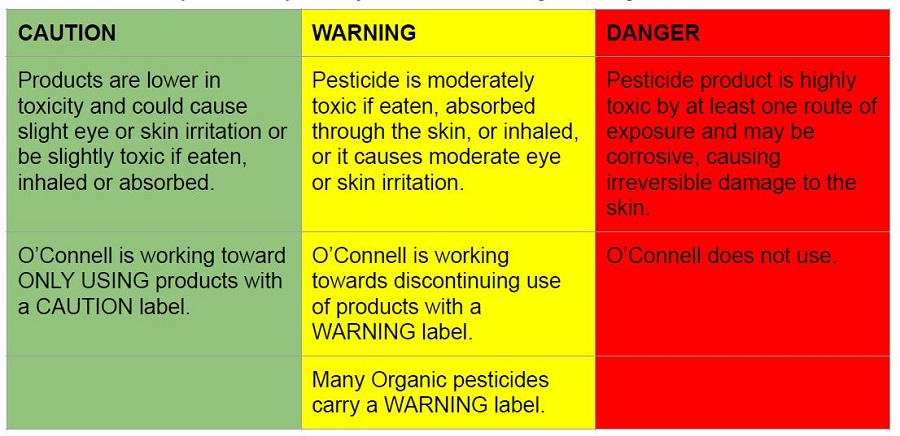
The majority of materials that O’Connell uses carry a ‘Caution’ label, a few others carry a ‘Warning’ label. They do not use any materials that use a ‘Danger’ label.
CAUTION
Products are lower in toxicity and could cause slight eye or skin irritation or be slightly toxic if eaten, inhaled or absorbed. O’Connell is working toward ONLY USING products with a CAUTION label.
WARNING
Pesticide is moderately toxic if eaten, absorbed through the skin, or inhaled, or it causes moderate eye or skin irritation. O’Connell is working towards discontinuing use of products with a WARNING label.
DANGER
Pesticide product is highly toxic by at least one route of exposure and may be corrosive, causing irreversible damage to the skin. O’Connell does not use. Some Organic pesticides carry a DANGER label.
Did you know?
Just because materials are labeled ‘organic’ doesn’t mean that they are safe or non-toxic. Most of the common organic materials carry a ‘Warning’ label and some even carry a ‘Danger’ label.
